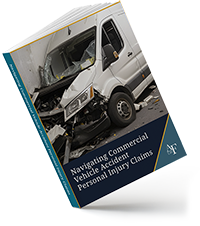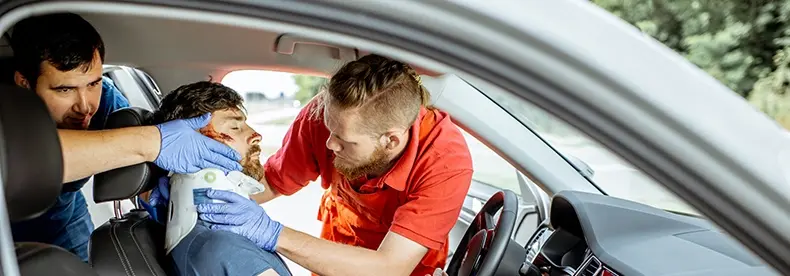Navigating Commercial Vehicle Accident Personal Injury Claims
How about a copy to-go?
Just fill out this quick form and read it when it's convenient for you.


When you're involved in an accident with a commercial vehicle, such as a semi-truck, bus, or delivery van, the aftermath can be overwhelming. You’re already dealing with physical injuries and emotional trauma, but you also face complex legal issues that differ significantly from typical car accident cases.
The personal injury claim process for commercial vehicle-related accidents involves unique challenges, from identifying liable parties to navigating intricate insurance policies and federal regulations.
Understanding this process is crucial for anyone seeking fair compensation after such an incident.
This guide will explain the essential steps of filing a commercial vehicle-related personal injury claim, help you understand your rights, and provide insights into maximizing your chances of a successful outcome.
Understanding Commercial Vehicle Accidents
Minnesota and Wisconsin both experience various accident types involving semi-trucks and buses, with some common patterns and frequencies:
- In Minnesota, truck accidents are a pressing issue. The state sees thousands of truck accidents each year, causing dozens of fatalities and injuries. These accidents often occur on major highways and interstates, usually within range of the Twin Cities. Common types of truck accidents in Minnesota include rear-end collisions, jackknife incidents, and rollover accidents, often worsened by harsh winter weather conditions.
- Wisconsin faces similar challenges with commercial vehicle safety and sees a higher frequency of accidents on its busiest highways and urban areas. However, Wisconsin's extensive rural road network also produces several commercial vehicle accidents, particularly during harvest seasons when agricultural vehicles frequently share the roads with other traffic.
Both states identified several common factors contributing to these accidents:
- Driver fatigue: Long hours on the road can lead to decreased alertness and reaction times.
- Distracted driving: Using mobile devices or in-cab technologies can divert driver attention.
- Speeding and aggressive driving: Pressure to meet delivery deadlines can result in unsafe driving behaviors.
- Poor vehicle maintenance: Neglected brake systems, tire issues, and other mechanical problems can lead to accidents.
- Weather conditions: Both states experience severe winter weather, which can be particularly challenging for large vehicles.
The high number of commercial vehicle accidents in both states underscores the ongoing need for improved safety measures, driver training, and public awareness to reduce the frequency and severity of these incidents on Midwestern roads.
Get a Free Case Consultation

Legal Frameworks
Minnesota and Wisconsin retain state and federal (FMCSA) laws governing commercial vehicle operation and accident claims. In some cases, state laws and federal regulations intersect, though there are other important considerations, like statutes of limitations and comparative fault systems.
Here is a summary of the primary legal statutes for commercial vehicle accidents in each state:
Minnesota adopted federal regulations but also has its own specific requirements.
-
- The state has strict size and weight limits for commercial vehicles.
- Insurance requirements are substantial, especially for vehicles transporting hazardous materials.
- Minnesota integrates the federal hours-of-service rules and CDL requirements into its state regulations.
- It also emphasizes regular vehicle maintenance and inspections and requires specific reporting requirements for accidents, which are important for both legal and safety reasons.
Wisconsin has also adopted federal regulations while retaining its own specific requirements.
-
- The state's size and weight limits for commercial vehicles are similar to federal standards, with some allowances for special permits.
- Insurance requirements vary, based on whether the carrier is operating interstate or intrastate, with higher requirements for hazardous materials transporters.
- Wisconsin also integrates federal hours-of-service rules and additional requirements, like annual medical examinations for CDL holders.
- Wisconsin allows for "Michigan Train" configurations with proper permits, which is a unique feature compared to some other states.
- Enforcement is carried out by the Wisconsin State Patrol, utilizing both fixed weigh stations and portable scales.
Both states vary in their statutes of limitations and comparative fault systems.
-
- Minnesota's 6-year statute of limitations is twice as long as Wisconsin's 3-year limit. This gives potential plaintiffs in Minnesota more time to investigate, prepare, and file their claims, which can be particularly beneficial in complex truck accident cases where gathering evidence and determining liability may take time.
- Both states use a modified comparative fault system with a 51% rule. This means that the plaintiff can’t sue for damages if they’re proven to be 51% or more at fault. Wisconsin’s laws are more specific on how damages are awarded in these cases.
These differences highlight the importance of understanding state-specific laws when dealing with truck accident cases. The choice of venue and the timing of filing a claim can significantly impact the outcome of your case.
Involved Parties
In a commercial vehicle claim, you’re likely not just dealing with the other driver and their insurance policy. You may also pursue damages against the driver’s company, the vehicle manufacturer, and even government entities.
It can help to know all the potential parties involved in a commercial vehicle accident claim. Here are several that you may encounter during the process:
- The driver. This person is the most directly involved party and the primary operator of the commercial vehicle. When determining liability, attorneys may review any evidence of distracted driving, fatigue, Hours of Service violations, speeding or reckless driving, driving under the influence, or failure to follow traffic laws or safety regulations.
- The trucking company. This is the driver’s employer. When determining liability, attorneys may review evidence of negligent hiring or retention of drivers, inadequate training, poor vehicle maintenance, Hours of Service violations, improper loading of cargo, or violations of federal or state trucking regulations.
- The truck manufacturer. This is the designer and producer of the truck and its components. When determining liability, attorneys may review evidence of design defects in the truck or its parts, manufacturing defects, recall failures for defective parts, or inadequate warnings about potential dangers.
- The cargo loading company. This is the company responsible for loading and securing cargo in the vehicles. When determining liability, attorneys may review evidence of improper loading techniques, overloading beyond weight limits, improper cargo securement, or inadequate training of loading personnel.
- Government entities. These are the local, state, and federal agencies that manage road design, maintenance, and signage. When determining liability, attorneys may review evidence of poor road design or maintenance, inadequate signage or warnings, or improper construction zone setup.
These parties aren’t the only ones involved. Depending on the context, you may also deal with maintenance companies, brokers, shippers, or other drivers. Regardless of the situation, you’ll likely encounter many more parties than in a typical passenger vehicle accident.

Types of Damages
In a personal injury case, “damages” are the monetary amounts awarded to the victim, covering various economic and non-economic needs. For accidents involving a commercial vehicle, damages are usually split among the following:
- Economic damages: These are calculated from actual monetary loss. They usually include medical expenses (both current and future), lost wages (including potential future earnings), and property damage.
- Non-economic damages: These are more subjective, and can vary significantly between cases. They include pain and suffering, emotional distress, and loss of enjoyment of life.
- Punitive damages: Minnesota and Wisconsin both allow for punitive damages in cases of extreme misconduct but with different standards and limitations. Wisconsin also has a specific cap on punitive damages, while Minnesota does not.
- Minnesota requires "deliberate disregard" for the rights or safety of the victim. Wisconsin requires "intentional disregard" or malicious conduct. In both cases, the offending party must have acted intentionally to cause harm or jeopardize the safety of others.
Major Challenges in Commercial Claims
Because you’re dealing with multiple additional parties (and countless additional laws and regulations), pursuing a commercial vehicle accident claim can be challenging. Victims often encounter several obstacles that can significantly impact the outcome of their case:
- Large truck companies (and large legal teams): Some companies have substantial resources to invest in their defense, including hiring top-notch attorneys and investigators. This is why you need experts in commercial vehicle claims to level the playing field.
- Difficulty in proving negligence: Victims and their attorneys must demonstrate that the trucking company or driver breached a duty of care, that this breach caused the accident, and that the accident resulted in damages.
- Multi-party liabilities: If multiple parties are involved, determining liability among these parties can be complex and time-consuming. Victims and their attorneys may need to file claims against multiple defendants or negotiate settlements with each party separately.
Choosing the Right Legal Representation
If you’ve been injured in an accident involving a commercial vehicle, make sure you find legal representation that understands these types of claims. When selecting an attorney, look for experience in handling commercial vehicle cases, a strong track record of success, and a commitment to client satisfaction.
